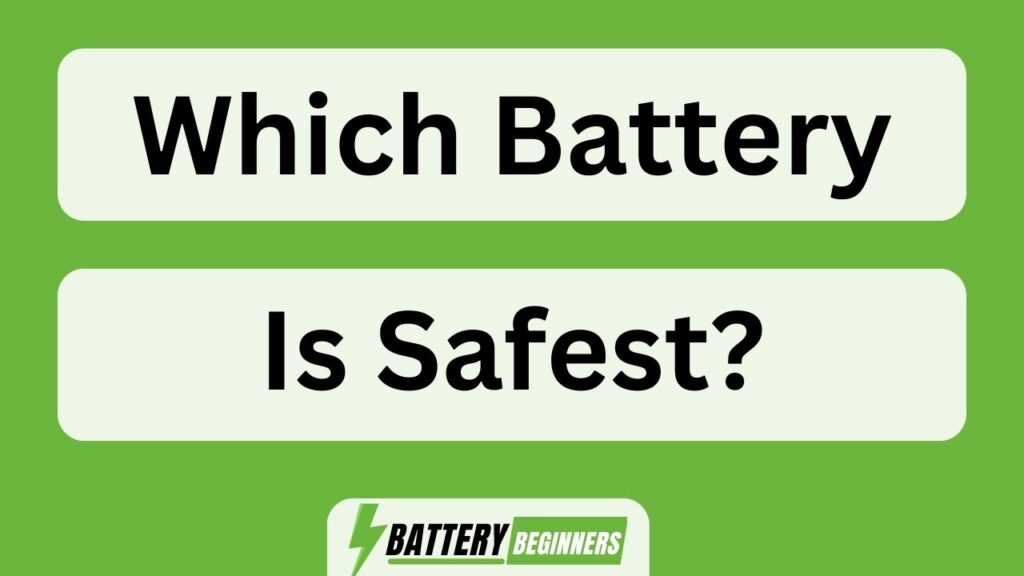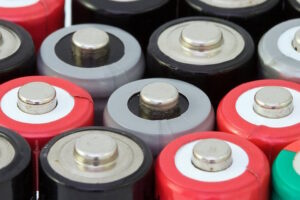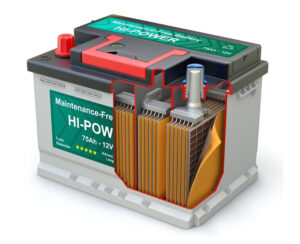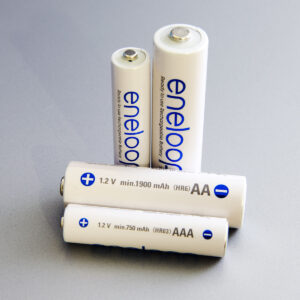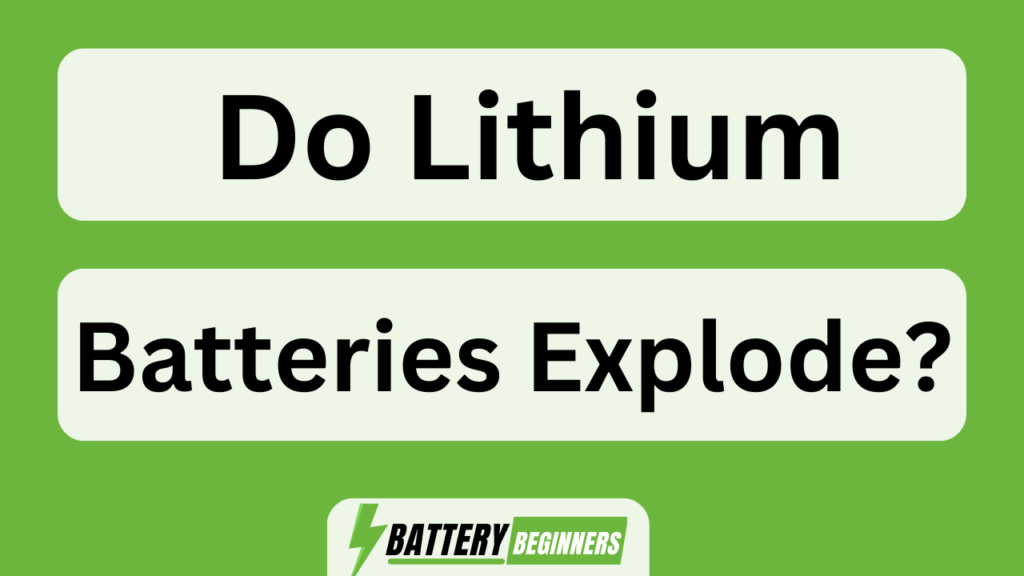In a world increasingly reliant on portable electronic devices and renewable energy sources, the safety of batteries has become a paramount concern. Like unseen powerhouses lurking within our devices, these energy storage systems have the potential to cause catastrophic accidents if mishandled or poorly designed.
This article delves into the comparative analysis of various battery types, such as Lithium-Ion, Lead-Acid, Nickel-Metal Hydride, Lithium Polymer, Sodium-Ion, Flow Batteries, Zinc-Air Batteries, and Hydrogen Fuel Cells. By examining their chemical compositions and inherent risks, we aim to determine which battery is safest for different applications.
Key Takeaways Of Which Battery Is Safest?
- Safety features in batteries include overcharge protection, short circuit protection, thermal management systems, and battery health monitoring.
- Lithium-ion batteries have been known to have safety concerns such as overheating and explosion risks.
- Sodium-ion batteries have shown progress in safety research and are considered a safer alternative.
- Solid-state batteries offer advantages in terms of safety, but there are challenges for widespread adoption due to technical and cost considerations.
Lithium-Ion Batteries
Lithium-ion batteries are widely used in various electronic devices due to their high energy density and long cycle life. These batteries have several advantages over other types of batteries.
Firstly, lithium-ion batteries have a higher energy density compared to traditional rechargeable batteries, allowing them to store more power in a smaller size. Additionally, they have a longer cycle life, meaning they can be charged and discharged more times before their capacity significantly decreases.
However, lithium-ion batteries also have some disadvantages. They are expensive to manufacture and require complex control systems to ensure safe operation. Furthermore, these batteries can be prone to overheating and thermal runaway if not handled properly.
Despite these drawbacks, lithium-ion batteries remain popular due to their superior performance and reliability.
Moving on to lead-acid batteries…
Lead-Acid Batteries
Lead-acid batteries are commonly used in automotive applications due to their low cost and high reliability. Despite their widespread use, lead-acid batteries have a significant environmental impact. The production of these batteries involves the extraction and processing of lead, which can contribute to soil and water pollution.
Additionally, lead is a toxic substance that poses health risks to humans and animals if not handled properly during the battery’s lifespan. However, lead-acid batteries have a well-established recycling process that helps mitigate some of these environmental concerns. The recycling process involves collecting used batteries, separating the lead from other materials, and reusing it in new battery production.
Transition: Moving on to nickel-metal hydride batteries…
Nickel-Metal Hydride Batteries
Nickel-Metal Hydride (NiMH) batteries are a popular alternative to lead-acid batteries due to their superior environmental friendliness and higher energy density.
NiMH batteries do not contain toxic heavy metals like cadmium or mercury, making them more environmentally friendly.
Additionally, they have a higher energy density compared to lead-acid batteries, allowing for longer durations of use in various applications.
However, despite these advantages, NiMH batteries still have certain drawbacks such as self-discharge issues and limited cycle life when compared to other battery types.
Environmental Friendliness and Energy Density
When considering the environmental friendliness and energy density of different battery types, it is essential to analyze their respective characteristics. One significant aspect to consider is energy efficiency, which refers to the amount of energy a battery can produce compared to the amount of energy it consumes during its lifetime. Nickel-Metal Hydride (NiMH) batteries have moderate energy efficiency, with an average discharge rate of 70-80% before needing recharging. Another crucial factor is recycling methods, as proper disposal reduces environmental harm and promotes sustainability. NiMH batteries are recyclable but require special facilities due to their toxic components. In terms of energy density, NiMH batteries have lower capacity compared to some other battery types such as Lithium-ion or Lead-acid. This means they contain less stored electrical energy per unit mass or volume. Transitioning into the subsequent section about safety features and benefits, understanding these factors aids in determining which battery type provides both environmental friendliness and optimal performance.
Safety Features and Benefits
One important consideration when evaluating battery types is the presence of safety features and the associated benefits. Safety features in batteries are designed to minimize potential risks and ensure safe operation during charging, discharging, and storage. These features include overcharge protection, short circuit protection, thermal management systems, and built-in sensors for monitoring battery health.
Overcharge protection prevents the battery from being charged beyond its capacity, reducing the risk of overheating or explosion. Short circuit protection detects and disconnects the battery in case of a short circuit, preventing damage to both the battery and connected devices. Thermal management systems help regulate temperature to prevent overheating. Built-in sensors monitor parameters like voltage and temperature to ensure optimal performance and alert users of any abnormalities.
The presence of these safety features not only reduces risks but also increases user confidence in using batteries for various applications without compromising safety.
Transitioning into the subsequent section about ‘applications and disadvantages’, it is important to consider how these safety features impact different usage scenarios.
Applications and Disadvantages
In the previous section, we explored the safety features and benefits of various batteries. Now, let’s delve into the applications and disadvantages of these batteries in comparison to their safety features.
While batteries have revolutionized portable electronics and renewable energy storage systems, they do come with certain limitations. One primary limitation is their finite lifespan, as repeated charging and discharging cycles lead to degradation over time. Additionally, some battery chemistries are prone to overheating and potential explosion under extreme conditions or when subjected to mechanical stress.
Furthermore, certain types of batteries require specific environmental conditions for optimal performance. These real-world limitations must be taken into consideration when selecting a battery for a particular application.
With an understanding of these drawbacks, we can now move on to discussing lithium polymer batteries in the subsequent section without compromising safety considerations.
Lithium Polymer Batteries
Lithium polymer batteries are often considered to be safer than other types of batteries due to their lower risk of thermal runaway. This is primarily because they use a gel-like electrolyte instead of a liquid electrolyte, which reduces the likelihood of leakage and combustion. Additionally, lithium polymer batteries have a stable structure that minimizes the chances of short circuits and internal damage.
In terms of environmental impact, these batteries are generally more eco-friendly compared to traditional lithium-ion batteries. They have a longer lifespan and can withstand a greater number of charge-discharge cycles, resulting in reduced waste generation.
Charging time is another advantage of lithium polymer batteries. Due to their high energy density, they can be charged at a faster rate compared to other battery types.
Transitioning into the subsequent section about sodium-ion batteries, it is worth noting that although lithium polymer batteries have several advantages, there is ongoing research focused on developing alternative technologies such as sodium-ion batteries with even better safety profiles.
Sodium-Ion Batteries
Sodium-ion batteries have gained considerable attention due to their abundance and cost-effectiveness. Sodium is a highly abundant element, making it a more sustainable and affordable option compared to other battery chemistries. However, safety concerns have been raised regarding the use of sodium as it is highly reactive with moisture and can lead to fire hazards.
Despite these challenges, research progress in sodium-ion batteries has been promising, with advancements in electrode materials and electrolyte solutions. Potential applications for sodium-ion batteries include large-scale energy storage systems and electric vehicles, although overcoming the challenges associated with low energy density and limited cycle life remains a major hurdle in their widespread adoption.
Abundance and Cost-Effectiveness
Abundance and cost-effectiveness are important factors to consider when evaluating the safety of different battery types.
In terms of abundance, sodium is one of the most abundant elements on Earth, making sodium-ion batteries an attractive option for renewable energy storage. Additionally, the manufacturing processes for sodium-ion batteries are relatively simple and utilize widely available materials, further contributing to their cost-effectiveness. This makes them a viable alternative to other types of batteries that rely on rare or expensive materials.
In order to ensure safety, it is crucial to address concerns such as thermal stability and potential leakage in sodium-ion batteries. Research efforts are ongoing to improve the performance and safety aspects of these batteries through the development of advanced electrolyte materials and more robust cell designs.
By addressing these concerns and continuing research progress, sodium-ion batteries have the potential to become a safer option for energy storage applications without compromising their abundance or cost-effectiveness.
Safety Concerns and Research Progress
Research progress is being made to address safety concerns in the development of advanced electrolyte materials and more robust cell designs for sodium-ion batteries. Recent research findings have highlighted the need for improved safety regulations to minimize the risk of accidents and ensure the safe use of these batteries. Several studies have focused on investigating the thermal stability, flammability, and toxicity of different electrolyte materials used in sodium-ion batteries. These findings have led to the development of safer electrolytes that exhibit enhanced resistance to thermal runaway reactions. Additionally, researchers have explored novel cell designs with improved structural integrity and heat dissipation capabilities to further enhance battery safety. By integrating these advancements into sodium-ion battery technology, it is anticipated that their overall safety profile will be significantly improved. Transitioning into the subsequent section about potential applications and challenges, it is important to consider these safety improvements alongside other factors when evaluating their feasibility for widespread adoption.
| Research Findings | Safety Regulations |
|---|---|
| Improved thermal stability | Enhanced regulatory standards |
| Reduced flammability | Stricter transportation guidelines |
| Lower toxicity | More comprehensive labeling requirements |
| Enhanced structural integrity | Stringent quality control measures |
| Improved heat dissipation | Rigorous testing procedures |
The table above summarizes some key research findings related to sodium-ion battery safety as well as corresponding safety regulations that could be implemented.
Potential Applications and Challenges
One potential application for sodium-ion batteries is in renewable energy storage systems, where they can be used to store excess electricity generated from sources such as solar or wind power. However, there are potential limitations that need to be addressed before widespread adoption can occur.
One major challenge is the relatively low energy density of sodium-ion batteries compared to other battery technologies. This limits their capacity to store large amounts of energy efficiently. Additionally, the limited number of available materials for sodium-ion battery electrodes and electrolytes poses another hurdle in terms of optimizing performance and reducing costs.
Despite these challenges, researchers are actively working on future developments to overcome these limitations. They are exploring new electrode materials with higher energy densities and improved stability. They are also investigating novel electrolyte formulations that can enhance the overall performance and safety of sodium-ion batteries.
Transitioning into the subsequent section about solid-state batteries, it is worth noting that this emerging technology holds promise in addressing many of the limitations associated with traditional liquid electrolyte-based batteries.
Solid-State Batteries
Solid-state batteries are a promising alternative to traditional lithium-ion batteries due to their improved safety features. They offer several advantages over conventional batteries, including reduced risk of fire and explosion due to the absence of flammable liquid electrolytes. Additionally, solid-state batteries have a lower environmental impact as they do not contain heavy metals like lead or cadmium.
In terms of performance comparison, solid-state batteries have a higher energy density, allowing for longer-lasting power storage. They also exhibit faster charging capabilities and improved cycle life, making them more durable in the long run.
However, there are still challenges that need to be addressed before widespread adoption can occur, such as high production costs and limited scalability.
As we move forward in exploring different battery options, flow batteries present another interesting avenue worth considering.
Flow Batteries
Flow batteries are a promising technology for scalable and long duration energy storage, making them suitable for grid-scale applications.
One of the key advantages of flow batteries is their ability to store large amounts of energy over extended periods of time, allowing for reliable power supply during peak demand periods.
Safety considerations in flow batteries primarily revolve around the choice of electrolyte, as certain electrolytes can be corrosive or toxic, requiring careful design and handling protocols. Additionally, the choice of electrolyte also affects the performance and efficiency of flow batteries.
In terms of market trends and applications, flow batteries are gaining traction in renewable energy integration, microgrid systems, and electric vehicle charging infrastructure due to their high energy density and long cycle life capabilities.
Scalability and Long Duration Storage
Scalability and long duration storage are key considerations when determining the safety of different battery types. Flow batteries have shown potential in addressing these requirements, particularly in the context of renewable energy integration.
However, scalability challenges still exist for flow batteries, as they often require large-scale installations to achieve cost-effectiveness. The ability to store energy for extended periods is another factor that needs to be taken into account when assessing the safety of flow batteries. Longer duration storage requires stable and reliable systems that can withstand prolonged operation without compromising safety.
In terms of electrolyte options, flow batteries offer a variety of choices, each with its own set of advantages and disadvantages in terms of safety and performance. Considering these factors will help determine which type of battery offers the safest option for scalable and long duration storage.
Safety Considerations and Electrolyte Options
One important aspect to consider when evaluating battery safety for scalable and long duration storage is the selection of appropriate electrolyte options. Electrolyte stability is crucial in ensuring the safe operation of batteries, as unstable electrolytes can lead to thermal runaway and other hazardous situations. Safety regulations also play a significant role in determining the suitability of electrolyte options for specific applications.
Various types of electrolytes are available, including aqueous, non-aqueous organic, and solid-state electrolytes. Each type has its own advantages and disadvantages in terms of performance, cost, and safety considerations. Aqueous electrolytes are generally more stable and have better thermal properties compared to non-aqueous organic electrolytes but may have limited voltage windows. Solid-state electrolytes offer enhanced safety features but may suffer from lower ionic conductivity. Consideration must be given to these factors when selecting an appropriate electrolyte option for scalable and long duration storage applications.
Transitioning into the subsequent section about ‘applications and market trends,’ it is essential to examine how battery safety considerations influence the development of new technologies and drive market demand.
Applications and Market Trends
The analysis of applications and market trends in battery technology is crucial for understanding how safety considerations impact the development of new technologies and shape market demand. In recent years, there has been a growing emphasis on environmentally friendly solutions, leading to increased interest in batteries with minimal environmental impact. This trend is driven by a greater awareness of the need to reduce carbon emissions and promote sustainability.
Additionally, the market for batteries has experienced significant growth due to the increasing demand for portable electronic devices, electric vehicles, and renewable energy storage systems. As a result, there is a strong focus on developing battery technologies that not only provide high performance but also offer improved safety features. These factors have influenced research efforts towards finding alternative electrolyte options that are both safe and environmentally friendly.
Moving forward into the subsequent section about zinc-air batteries…
Zinc-Air Batteries
Zinc-air batteries are a promising energy storage technology due to their high energy density and low cost. With the ability to store large amounts of energy in a compact size, these batteries have the potential to revolutionize various industries, including electric vehicles and portable electronics.
However, there are safety measures and challenges that need to be addressed before zinc-air batteries can be widely adopted. These include preventing the formation of dendrites that can cause short circuits, managing the release of oxygen during discharge, and ensuring proper ventilation to prevent overheating.
Despite these challenges, ongoing research and advancements in materials and design are expected to improve the overall performance and safety of zinc-air batteries.
High Energy Density and Low Cost
High energy density and low cost are important factors to consider when determining the safety of a battery. Zinc-air batteries possess these desirable qualities, making them an attractive option in various applications. These batteries offer high power capabilities, allowing them to deliver significant amounts of energy over a short period. This makes them suitable for devices that require bursts of power, such as hearing aids and electric vehicles. Additionally, zinc-air batteries have a relatively low environmental impact compared to other battery types due to their use of non-toxic materials.
Furthermore, zinc-air batteries exhibit high efficiency and performance levels. They can convert chemical energy into electrical energy with remarkable effectiveness, ensuring optimal utilization of resources. In terms of cost-effectiveness, these batteries are relatively inexpensive to produce due to the abundant availability and low cost of zinc. This affordability factor makes zinc-air batteries an appealing choice for mass production.
Transitioning into the subsequent section about ‘safety measures and challenges,’ it is crucial to understand how these advantageous characteristics align with potential risks and limitations inherent in using zinc-air batteries.
Safety Measures and Challenges
One of the key considerations when using zinc-air batteries is understanding the safety measures and challenges associated with their use. Safety regulations play a vital role in ensuring that these batteries are used safely and efficiently. Risk assessment is an essential part of this process, as it helps identify potential hazards and develop appropriate mitigation strategies. Additionally, proper handling and storage procedures must be followed to minimize the risk of accidents or damage. Challenges in maintaining battery safety include preventing leakage of electrolyte, managing temperature fluctuations, and addressing potential fire hazards. It is crucial for manufacturers and users to adhere to safety guidelines to prevent any mishaps or risks associated with zinc-air batteries.
Transitioning into the subsequent section about applications and advancements:
As safety measures continue to evolve, there have been significant advancements in the field of zinc-air battery applications.
Applications and Advancements
In recent years, significant advancements and a wide range of applications have been observed in the field of zinc-air battery technology. Zinc-air batteries are known for their high energy density and low cost, making them attractive for various applications such as electric vehicles, grid energy storage, and portable electronics. Advancements in battery technology have led to improvements in the performance of zinc-air batteries, including increased efficiency and longer cycle life. Additionally, ongoing research aims to address challenges related to the stability of zinc electrodes and air cathodes. Future applications of zinc-air batteries include integration with renewable energy systems, enabling sustainable power generation and storage. These advancements demonstrate the potential of zinc-air batteries as a safer alternative in various industries. Transitioning into the subsequent section about sodium-ion batteries, these innovative technologies hold promise for further enhancing battery safety and performance.
Sodium-Ion Batteries
Sodium-ion batteries have gained attention as potential alternatives to lithium-ion batteries due to their abundance and cost-effectiveness. Sodium is more abundant than lithium, making sodium-ion batteries a more sustainable option. However, safety concerns surrounding the use of sodium in batteries still need to be addressed through further research.
Despite these challenges, sodium-ion batteries hold promise for various applications such as grid energy storage and electric vehicles, but commercialization remains a challenge due to the need for improvements in performance and stability.
Abundance and Cost-Effectiveness
When considering the abundance and cost-effectiveness of different batteries, it is important to evaluate their availability and economic viability.
Sodium-ion batteries (SIBs) have gained attention due to the abundance of sodium resources compared to other metals used in batteries. This abundance can potentially make SIBs more cost-effective, as they do not rely on scarce materials. Furthermore, sodium is less expensive than lithium, which is commonly used in lithium-ion batteries.
However, it is crucial to assess the value provided by SIBs in relation to their cost. The performance and energy density of SIBs are still being improved upon, which may affect their overall cost-effectiveness when compared to other battery technologies.
Transitioning into safety concerns and research progress, understanding the availability and economic aspects helps provide a comprehensive overview of sodium-ion batteries’ potential as a safe alternative for future energy storage solutions.
Safety Concerns and Research Progress
Safety concerns and research progress regarding sodium-ion batteries have been a significant focus in the development of future energy storage solutions. Research findings indicate that while sodium-ion batteries offer promising advantages such as high energy density and low cost, safety issues remain a major concern. The main challenge lies in the instability of sodium-metal anodes, which can lead to dendrite formation and cause short circuits or even explosions. Safety regulations are being implemented to address these risks, but further research is needed to ensure the safe operation of sodium-ion batteries.
Additionally, ongoing studies aim to improve the thermal stability and cycle life of these batteries through advanced materials and design modifications. Understanding these safety concerns and making progress in research will contribute to overcoming potential challenges in their practical applications.
Transitioning into the subsequent section about ‘potential applications and challenges’, it is important to consider other factors beyond safety when exploring the viability of sodium-ion batteries.
Potential Applications and Challenges
One of the key challenges in exploring the potential applications of sodium-ion batteries lies in addressing their limited cycle life and thermal stability. These limitations pose significant challenges in implementing sodium-ion batteries as a viable alternative to other battery technologies.
Despite these challenges, there are potential benefits to using sodium-ion batteries. For instance, they offer a higher energy density compared to traditional lithium-ion batteries, which can lead to longer-lasting power sources for various applications. Additionally, sodium is more abundant and less expensive than lithium, making it a potentially cost-effective solution for large-scale energy storage systems.
However, further research is needed to improve the cycle life and thermal stability of sodium-ion batteries before they can be widely adopted across different industries.
Transitioning into the subsequent section about hydrogen fuel cells, advancements in this field may provide alternative solutions to address these challenges without compromising performance or safety.
Hydrogen Fuel Cells
Hydrogen fuel cells are considered a safer alternative to traditional batteries. Not only do they offer numerous environmental benefits, but they also exhibit higher efficiency and performance levels. Unlike conventional batteries that rely on chemical reactions, hydrogen fuel cells generate electricity through the reaction between hydrogen and oxygen, producing only water as a byproduct. This clean energy conversion process significantly reduces carbon emissions and minimizes the negative impact on air quality compared to fossil fuel-powered generators or internal combustion engines.
In terms of efficiency, hydrogen fuel cells have shown great promise. They can convert more than 50% of the energy stored in hydrogen into usable electricity, which is much higher than the average efficiency of internal combustion engines. Additionally, these fuel cells provide constant power output throughout their operation without experiencing significant degradation or loss in performance over time.
To emphasize the advantages of hydrogen fuel cells further, consider the following table:
| Aspect | Hydrogen Fuel Cells | Traditional Batteries |
|---|---|---|
| Environmental Impact | Minimal | Substantial |
| Efficiency | High | Variable |
| Performance | Consistent | Declines over time |
Overall, hydrogen fuel cells demonstrate superior environmental impact, efficiency, and performance compared to traditional batteries. Their growing use in various applications reflects their potential as a safer and more sustainable energy storage solution for the future.
Frequently Asked Questions
Are all batteries equally safe to use in electronic devices?
Battery safety is an important consideration when choosing a battery for electronic devices. While not all batteries are equally safe, common battery hazards include overheating, leaking, and explosion. It is crucial to select a battery that meets the necessary safety standards.
What are the potential risks associated with lithium-ion batteries?
Potential risks associated with lithium-ion batteries include thermal runaway, which can lead to fires and explosions. Safety concerns arise from their high energy density, potential for short circuits, and sensitivity to overcharging or overheating.
How do lead-acid batteries compare to other types of batteries in terms of safety?
When comparing battery safety, lead-acid batteries generally have a higher safety profile compared to lithium-ion batteries. This is due to their less volatile chemistry and lower risk of thermal runaway events.
Are there any specific safety concerns with nickel-metal hydride batteries?
Safety concerns with nickel-metal hydride batteries include the potential for overheating and gas release. In comparison to other batteries, they have a lower risk of explosion but require proper handling and storage to prevent leakage or short circuits.
Are there any unique safety considerations to be aware of when using hydrogen fuel cells?
Hydrogen fuel cell safety requires unique considerations. Potential hazards include hydrogen leaks, which can be flammable and explosive. Adequate ventilation and proper handling procedures are necessary to mitigate risks associated with hydrogen fuel cells.
Conclusion
In conclusion, the investigation into the safety of various battery types reveals important insights.
Lithium-ion batteries, despite their high energy density and popularity in electronic devices, have been associated with safety concerns due to their potential for thermal runaway.
Lead-acid batteries, although widely used in automotive applications, pose risks related to acid leakage and heavy metal pollution.
Nickel-metal hydride batteries offer a safer alternative but have lower energy density.
Sodium-ion batteries show promise as a safe and sustainable option, while flow batteries demonstrate excellent safety characteristics but are less commercially available.
Zinc-air batteries exhibit good safety features but face challenges related to stability and efficiency.
Lastly, hydrogen fuel cells are considered safe when handled properly but require cautious handling due to their flammable nature.
It is imperative for consumers and industries alike to carefully consider these factors when selecting the safest battery for their specific needs.
